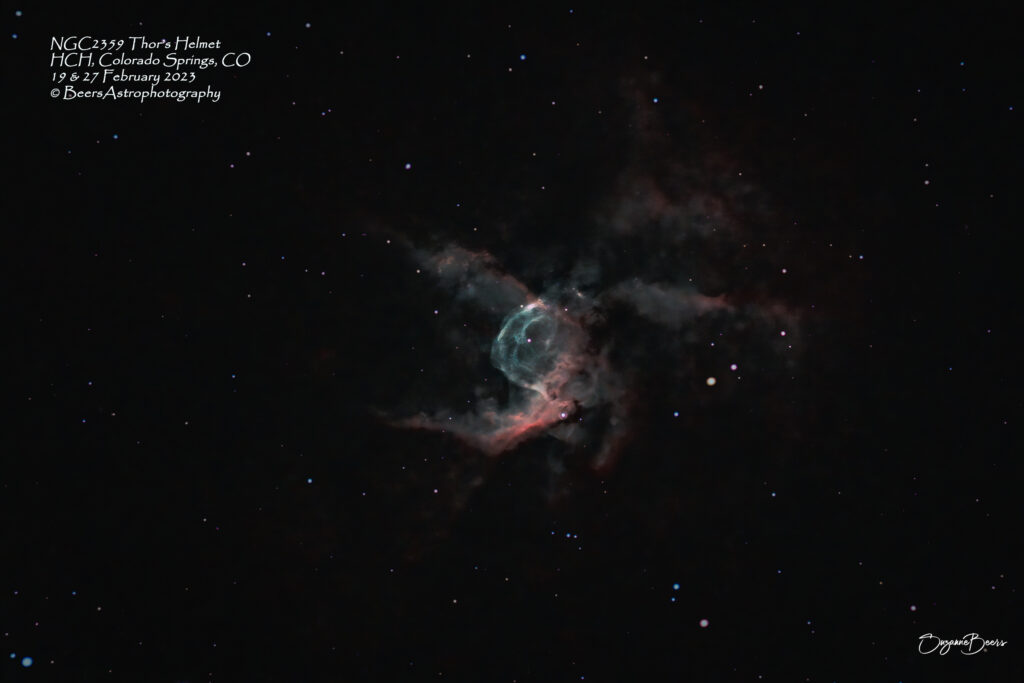
Fun facts
NGC 2359 Thor’s Helmet is an emission nebula in the constellation Canis Major. The nebula is approximately 11.96 thousand light years away and 30 light-years in size. The central star is the Wolf-Rayet star WR7, an extremely hot star thought to be in a brief pre-supernova stage of evolution. It is similar in nature to the Bubble Nebula, but interactions with a nearby large molecular cloud are thought to have contributed to the more complex shape and curved bow-shock structure of Thor’s Helmet.
The nebula has an overall bubble shape, but with complex filamentary structures. The nebula contains several hundred solar masses of ionized material, plus several thousand more of unionized gas. It is largely interstellar material swept up by winds from the central star, although some material does appear to be enriched with the products of fusion and is likely to come directly from the star. The expansion rate of different portions of the nebula varies from 10 km/s to at least 30 km/s, leading to age estimates of 78,500 – 236,000 years. The nebula has been studied at radio and x-ray wavelengths, but it is still unclear whether it was produced at the class O main sequence stage of development, as a red supergiant, luminous blue variable, or mainly as a Wolf-Rayet star.
Other Catalog Designations: GUM 4, LBN 227.66-00.09, SH 2-298, GRS 227.80 -00.20, LBN 1041, RCW 5
Subtype: Emission Nebula
Distance from Earth: 11,960 light years
Size: 30 light years
Constellation: Canis Major
{From: https://en.wikipedia.org/wiki/NGC_2359}
Capture Notes
Returned from DAF SAB February trip to Edwards on Friday, 17 February with the plan to depart for a dark skies trip on Saturday morning. Watching the weather all week had the number of clear nights ranging from zero to one at both Kiowa and Comanche. On Friday, we made the call that since the forecast was for a single clear night (Saturday) and winds, it was not worth the trip. Of course, as soon as we made that decision, it turned out that we had clear skies in Colorado Springs on Saturday (and Sunday and Monday) – so I shot from the front patio. Since there was going to be no moon during the dark hours, decided to try shooting with no light pollution filter – and two set-ups: ASI2400 on the SC (Askar600 and RC-135E mount) and Canon EOS Ra on BZ (EQ6R mount). The idea of shooting without a light pollution filter was not a good one. The idea of shooting with two setups also did not pan out – but did reveal that the backup control laptop (HCV hand-me-down laptop from Paul) did not have the processing capability to act as a control laptop. The next day, Paul ordered a new, second control laptop – another HP Probook.
Imaging on the 19 February was with the “old” HP Probook (DSO CTRL 1), Big Zeus, ASI2400MC, and the LPro light pollution filter. The beginning of the session, I also had the Teleskop field flattener in the imaging train, but when I went out to accomplish the meridian flip, decided that it was still creating too much coma on the corners of my image. I noted the issue with the FF very severely during the imaging with ASI2400MC and BZ on 18Feb – Tolga (https://www.tolgaastro.com/ – as he states on his website – the BEST customer service in astrophotography!!) stated the cause was that the filters were too far from the sensor. So this image train took off the second extension sleeve and connected the FF directly to the shorter one. It wasn’t as severe, but still present. Taking it off all together seemed to produce an image without noticeable coma (i.e., the Ra needs it but the ASI2400MC doesn’t).
Imaging on the 27 February was with the new HP Probook (DSO CTRL 2) to test out the new setup. Only 5 images were captured during the 1:30+ hour imaging session. Unbeknownst to me there were two issues – one (and most debilitating) was that I had the power set to go to sleep when I closed the lid. Also, there was a download issue – that I discovered the next night when I abandoned imaging due to the wind (the wind moved the BZ in RA by 90 degrees!), bringing everything inside, I decided to capture new dark frame library with the changed offset value and ran into the same download issue. “Fixed” it by setting up the sequence on that computer, rather than copying one developed on DSO CTRL 1 and applying the camera only sequence.
This image is all the data collected on 19 February and 27 February 2023.
Equipment
Polar alignment: QHYCCD camera (controlled by Polemaster)
Imaging stream: Orion 10″ f/8 Ritchey-Chretien Astrograph Telescope, ZWO ASI2400MC imaging camera with (19Feb2023) Teleskop Service Flattener 1.0x for RC Telescopes (TS-RCFLAT2) (half the session) and Optolong L-Pro and (27Feb2023) Optolong L-Extreme LP filter
Mount: Sky-Watcher EQ6-R Pro Equatorial Mount (controlled by EQMOD)
Autoguider: Orion 60mm Multi-Use Guide Scope, Orion StarShoot AutoGuider Pro Mono Astrophotography Camera (controlled by PHD2)
19 Feb2023 equipment controlled by HP Probook (DSO CTRL 1) running Sequence Generator Pro v3.2.0.660. 27Feb2023 equipment controlled by HP Probook (DSO CTRL 2) running SGP 4.10
Capture & processing notes
Sequence plan:
Night 1: 19Feb2023: Gain: 158, Temp: -0°C, no offset. BZFFLPro 23x5min; Captured 19Feb2023, 1913MST – 2140MST. Total exposure time: 1:55hrs BZLPro (no FF) 20x5min. Captured 19Feb2023, 2201MST – 19Feb2023, 2336MST. Total exposure time: 1:40hrs
Night 2: 27Feb2023: Gain: 158, Temp: -0°C, Offset: 30. 5x5min. Total exposure time: 25min. Captured 27Feb2023, 2001MST – 2106MST.
Total exposure time: 4hrs (with FF data); 2:20hrs (without FF data).
Capture: 19 & 27 February 2023
Shooting location: Colorado Springs, Colorado
Processing: Stacked in APP, processed in LR/PS.
